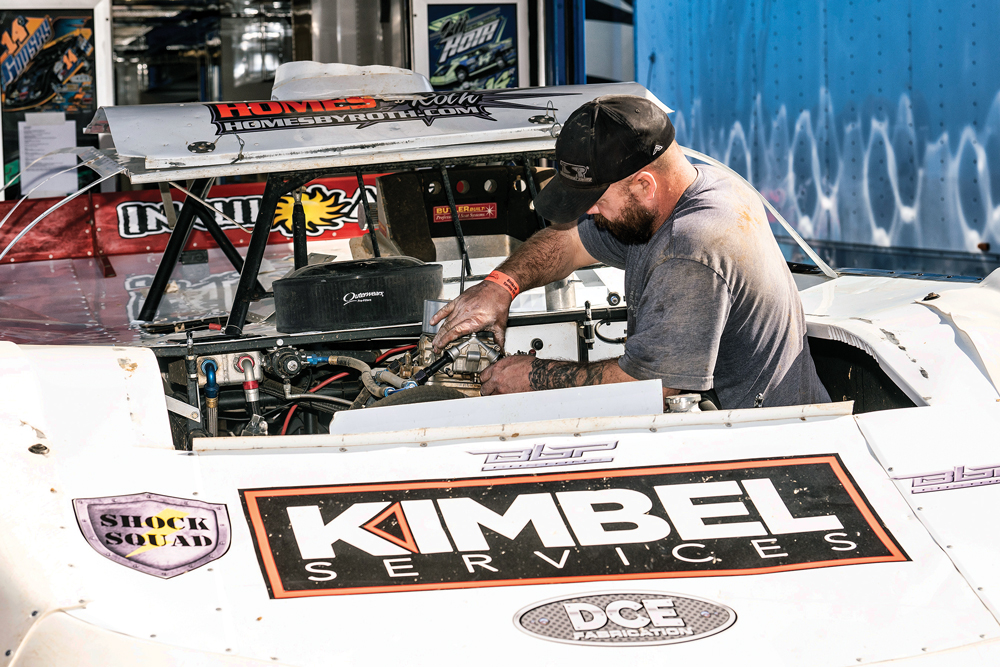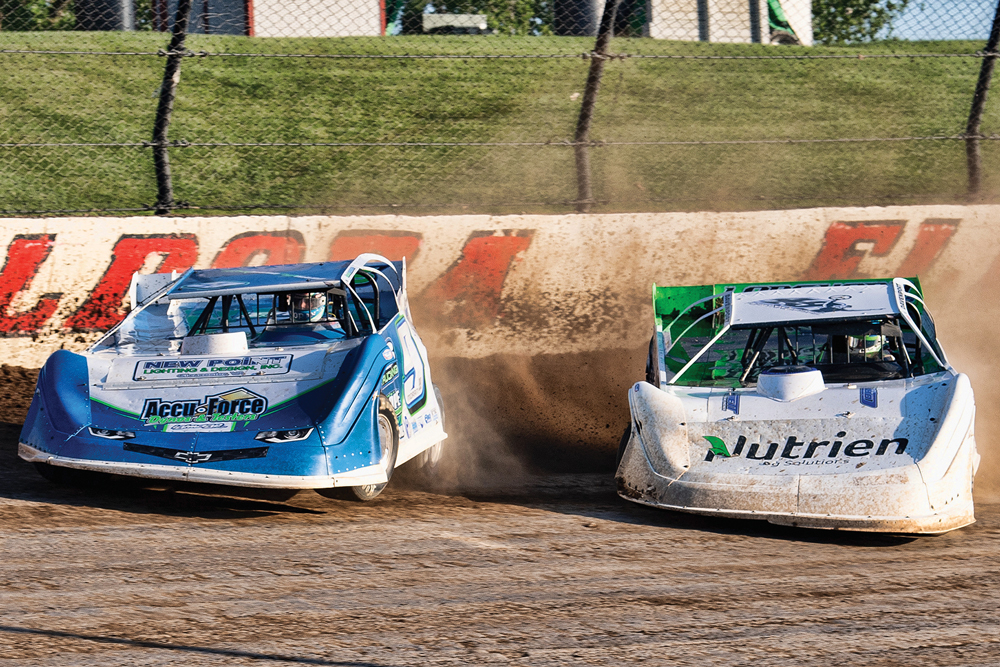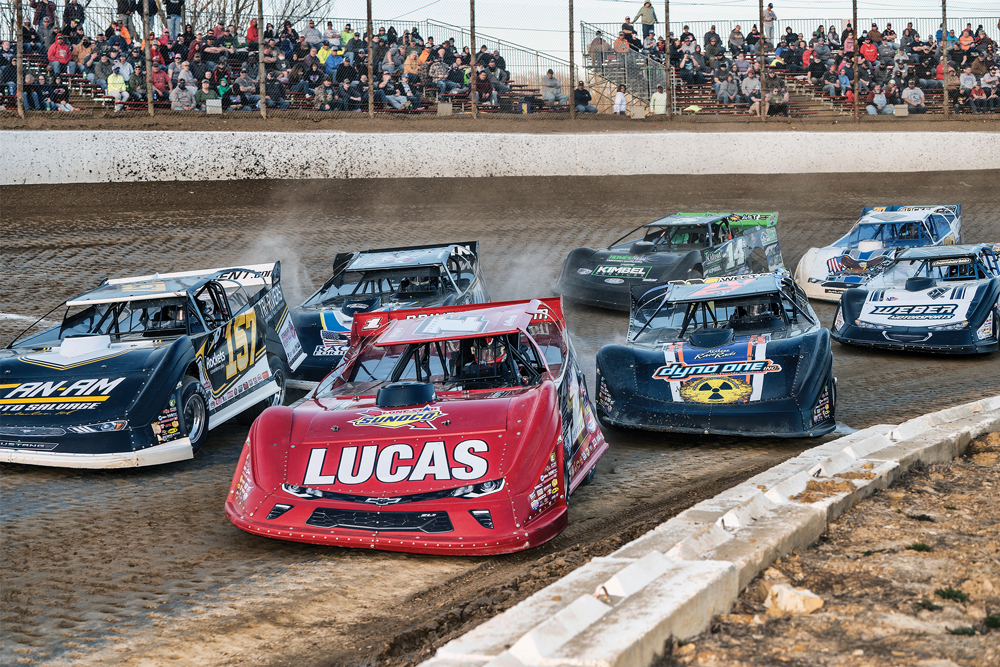Innovation vs. Regulation: How Dirt Late Model Racing Is Finding A Balance

Photo courtesy of World of Outlaws
As teams look to the gray areas of the rulebook to find a competitive edge, sanctioning bodies are walking a tightrope between rising costs and overreaching mandates.
Although the popularity of super late model, crate late model, and other divisions tends to vary from one region to another, one trend is ostensibly universal: As dirt late model racing has seen continued growth in recent years on the whole, the intensity of the competition has risen in turn.
“Even in areas where there may be lower car counts, the quality is up,” said Jim Bernheisel of Bernheisel Race Cars, Jonestown, Pennsylvania. “So where there might have been six out of the 20 cars in an event who could potentially win that race in the past, now it’s 18 out of 20. They have the experience and the equipment, and they’re race winners.”
Close competition is undoubtedly great for the fans and dirt late model racing in general, but as the gaps become narrower and narrower, teams are on the hunt for every possible advantage they can find while still complying with a given rule set as it’s written. “It can actually be discouraging for some racers,” Bernheisel explained. “There are some that just aren’t going to be able to perform as well as others due to budget constraints. Racers tend to be their own worst enemy in that way—they will just spend themselves into oblivion if you let them.”
To that end, sanctioning bodies are given the difficult task of curbing the costs to prevent some teams from being pushed out of competition while also being careful not to turn dirt late model racing into a spec-style discipline with an exhaustive tech inspection process and very little room for ingenuity. While that equilibrium tends to be a moving target, officials appear to have honed in on some effective solutions.
Setting Guidelines
In years past, many teams focused much of their energy on refining their engine package, and that makes sense when considering the fact that many dirt late model racing divisions have very few restrictions on engine modifications. But more horsepower doesn’t necessarily translate to a faster race car.
“The majority of these guys are running in the 430-cubic-inch range,” said Casey Shuman of the World of Outlaws Morton Buildings Late Model Series, Concord, North Carolina. “There’s some that are bigger, and that might help a little during qualifying, but on a nightly basis, most of these racers are putting restrictors in and trying to actually take away horsepower to improve drivability.”

So while open engine rules might seem like an inherent advantage for well-heeled teams, outside factors tend to self-police this aspect of the racing. “There’s only so much available traction on a dirt race track,” said Steve Francis of the Lucas Oil Late Model Dirt Series, Batavia, Ohio. “Pretty much across the board, teams de-tune their engines after qualifying with restrictor plates and that type of thing in order to keep the tires hooked up to the race track. Over the course of a night, the track surface tends to change and the grip levels go down. But the teams are getting better about tuning for those changes; six or seven years ago you might have seen a track slow down by three or four seconds in a night, but that change is down to about a second now.”
Tiffany Olson of Sycamore Speedway in Maple Park, Illinois, pointed out that horsepower advantages can be addressed through other means as well. “We have a three-link super late model division, for instance, so they’re restricted to that suspension design, and these racers are required to purchase a specific tire from us. Rules like these allow us to have better control over the parity between the cars.”
And this largely hands-off attitude toward engine rules appears to be working. “We don’t get a lot of calls from people saying they need more and more power,” said Tony Clements of Clements Racing Engines, Spartanburg, South Carolina. “But we do get a lot of phone calls from teams saying that they need better drivability, and more usable power. We can definitely develop these engines to have more power, but at a certain point the cars become hard to control. If the engine blows the tires off halfway down the straight, it’s not making the car faster. It’s really more about making the power available where it needs to be.”

The Tuning Renaissance
So if power levels have already surpassed what can feasibly be put down on dirt, where does a team turn their attention to improve the car’s performance?
“There’s a lot of really smart people involved in dirt late model racing, and they’re changing things from week to week, it seems,” Shuman said. “But one area where we’ve seen things change a lot over recent years is the suspension. Teams are really stepping things up with the shock and spring packages they’re running, and how it works together with their aero.”
And Olson noted that a big part of the change comes from the realization that suspension components tend to be the most cost-effective way to refine the car’s performance. “There’s been this transformation. The focus used to be all about the engines; now it’s the chassis and the suspension setup. When it comes to bang-for-the-buck today, those components tend to play a more vital role than the horsepower levels do, and racers are doing a better job of educating themselves about it. We’ve seen teams that were struggling a bit go back and update their chassis, or shocks, or springs, and all of a sudden they’re right back in the mix.”
And as a result, chassis, suspension, and aero have become a focus for sanctioning bodies and tracks as well. “Aerodynamics play a significant role even in short track racing,” said Bernheisel. “And as more and more people get on board with that idea, rules are being developed to try and prevent it from getting out of hand. That started with car body limits, but racers figured out how to manipulate suspension so they could improve the aerodynamic efficiency while still meeting those requirements. So in order to address that, organizers have also incorporated some chassis and suspension rules to limit those aerodynamic advantages, and it translates to a lot more hoops to jump through in order to build your race car.”
But these rules also promote an even playing field. “These kinds of regulations help to keep the costs down on the cars,” said Francis. “You shouldn’t need a team of engineers in order to be competitive in dirt late model racing. Racers are happy to see the issues being addressed, and the builders are selling more cars and engines than they can produce right now.”
At a certain point, however, regulations can become more of a burden than a benefit. “It’s just not possible to go through every single rule during tech each night,” Shuman said. “And some of the rules are a bit outdated at this point. I think we could focus 10 or 12 of the major ones—places where costs could get out of control, or safety is a concern—and otherwise simplify things a bit while providing the teams with enough room for ingenuity. Nobody wants to make this into a series where everyone is running the exact same car and setup. I love it when a team can come up with a better way to do things and win a race with it—that’s a very cool part of our sport.”

And from Bernheisel’s perspective as a chassis builder, an overly restrictive rule set can be a source of frustration. “We wish there was enough leeway to have some innovation. If we came up with a new suspension component and it was wildly successful, it would probably get outlawed. And to me, that kind of takes some of the fun out of it. We understand why it’s done—they don’t want to see everybody rushing out to buy the latest thing and be constantly changing their cars. But everyone already does that anyway.”
Motorsports regulation has always been rife with compromise, but all parties seem to agree that maintaining fair, cost-effective competition is the main objective for dirt late model racing going forward.
“When the racing is fair, more people want to come to the races,” Olson said. “If you’re putting all of your time, effort, and money into something, you want some assurance that your hard work isn’t going to just be brushed away.”
Francis cited sprint car racing as an example. “Seven or eight years ago it was really struggling with car counts and things like that. They got on a universal tire spec across the country and standardized the rules, and now sprint car racing is doing really well. If you’ve got one guy that’s done something that is way out of bounds, you try to bring that one car back in bounds rather than forcing two thousand other cars to change to catch up with him. These guys don’t want to have to buy a new race car every year because it’s suddenly outdated.”
“Racers want consistency,” Shuman added. “I think that whatever rules we’re going to have, racers just want to know that everyone is racing under those rules.”
SOURCES
–
Bernheisel Race Cars
bernheiselracecars.com
Clements Racing Engines
Lucas Oil Late Model Dirt Series
lucasdirt.com
Sycamore Speedway
sycamorespeedway.com
World of Outlaws Morton Buildings Late Model Series
worldofoutlaws.com/latemodels
 MEMBERSHIP LOGIN
MEMBERSHIP LOGIN JOIN PRI
JOIN PRI


